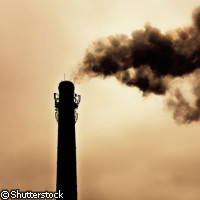Ten billion tonnes of carbon released in 2007
A new Global Carbon Budget has been released by the Global Carbon Project. The updated report shows that carbon dioxide (CO2) emissions from fossil fuel combustion and land use change reached 10 billion tonnes of carbon in 2007, that the rate of atmospheric CO2 growth is approximately four times faster since 2000 than in the previous decade, and that the efficiency of natural carbon sinks has declined. The new report concluded that: 'All of these changes characterise a carbon cycle that is generating stronger climate forcing and sooner than expected'. Burning fossil fuels, deforestation and the manufacture of cement (including limestone breakdown) were seen as the biggest CO2 offenders: emissions from burning fossil fuels and manufacturing cement alone have grown from 6.1 billion tonnes of carbon in 1992 to 8.5 billion tonnes in 2007. CO2 emissions have increased dramatically despite international efforts, such as the ratification of the Kyoto Protocol by 181 countries (with the notable exception of the US) to curb the growth of greenhouse gas emissions. The new Global Carbon Budget reported on carbon emissions due to human activity as well as carbon removal by natural sources. The report reveals that atmospheric CO2 levels increased on average by more than 2 parts per million (ppm) per year between 2000 and 2007; in the previous two decades, it increased by 1.5 ppm per year. The final product, an atmospheric concentration of 383 ppm in 2007, is 37% above that of 1750 and represents the highest concentration in the past 650,000 years. Land use change, mostly generated by deforestation in tropical countries, was responsible for net emissions of 1.5 billion tonnes of carbon to the atmosphere. Fossil fuel combustion and cement manufacture contributed 8.5 billion tonnes of carbon emissions in 2007, which is 38% more than in 1990. Between 2000 and 2007 emissions increased by 3.5% per year which, according to the report, 'exceeded the highest forecast growth rates for the decade 2000-2010 in the emissions scenarios of the Intergovernmental Panel on Climate Change, Special Report on Emissions Scenarios (IPCC-SRES)'. From 2000 to 2007 natural CO2 sinks (such as forests and oceans) absorbed on average 4.8 billion tonnes of CO2 emitted from human activities per year, 3% less than in previous decades. While the actual size of these natural sinks has grown in proportion to increasing atmospheric CO2, their efficiency has decreased by 5% in the past 50 years and is expected to decline further. Natural ocean CO2 sinks removed 25% of all CO2 emissions, averaging 2.3 billion tonnes per year. In 2007 the oceanic CO2 sink was about the same size as in 2006 but its efficiency was reduced, absorbing 0.1 billion tonnes less than expected. The report attributes this in part to the presence of a 'La Niña' event in the Pacific Ocean. In terms of the ocean's long-term ability to absorb CO2, the ocean CO2 sink shows slower growth than expected. Natural land CO2 sinks removed 29% of emissions caused by human activity between 2000 and 2007, averaging 2.6 billion tonnes per year. Interestingly, the report says that these ecosystems removed less CO2 in 2007 than in 2006, but that this highlights the high year-to-year variability of the sink; long-term trend analyses show that the terrestrial CO2 sink has grown over the past 50 years. Developing countries such as China and India showed the largest increase in emissions, while CO2 emissions from developed countries continue to grow slowly. China overtook the US as the largest CO2 emitter in 2006 (although China's National Energy Administration has reported improvements since 2005) and India is expected to overtake Russia to become the third largest emitter in the coming years. The new budget reports that 'the carbon intensity of the global economy [...] was stalled during the period 2003-2005. This change was largely caused by China's rapidly growing share in economic output and carbon emissions'. As of 2007 more than half the world's greenhouse gas emissions come from developing countries, which are home to 80% of the world's population. The Project's report provides a historical perspective, pointing out that emissions from these countries account for only 20% of cumulative emissions since 1751, and cumulative contributions from the world's poorest countries are less than 1%. Professor Corinne Le Quéré from the British Antarctic Survey and the University of East Anglia in the UK, commenting on the global economy's dependence on fossil fuels, said that, 'If this trend continues and the natural sinks weaken, we are on track towards the highest projections of climate change'. The Global Carbon Budget is compiled annually by the Global Carbon Project. A number of EU-funded projects contribute to the Global Carbon Project, including the Integrated Carbon Observation System, the CarboEurope Integrated project, the CARBOCEAN project, and CARBO-North, a project involving scientists from across northern Europe, Russia and the US.

